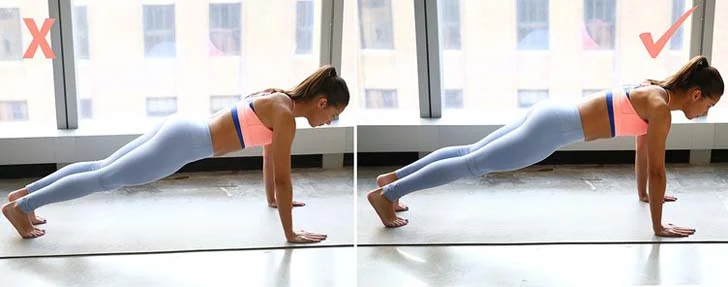Your abs will thank you later.

By Meg Lappe, Self
Your core is the base of all your power
during exercise. You use it in pretty much every single move, whether
you really feel it or not. There are a zillion ways to work your abs, but one move you'll see over and over again is the simple and effective plank. While it looks easy, if you're doing it with proper form, you'll feel everything from your abs to your glutes working hard. And no, that shouldn't feel easy.
[post_ads]Planks
require a lot of different core muscles. "They work your entire core
center, which consists of the front, back, and side muscles of your
body," Amy Opielowski, senior manager of quality and innovation at CorePower Yoga,
tells SELF. "These muscles include your rectus abdominis, obliques,
transverse abdominis, pelvic floor muscles, glutes, spinal extensors,
and inner and outer thighs."
You're
likely to see planks in almost every class from dance cardio, to boot
camps, to Pilates. That's because they're not only efficient, but simple
to modify, fun to progress, and easy to integrate into your workout.
"Planks
are a foundational movement. Mastering your traditional plank and
working on it weekly, even daily, will help you perform other, more
advanced core exercises in no time," Laura Mucci, trainer at EverybodyFights, tells SELF. Plus, you really need a strong core to help you do everyday movements like squatting, lifting, or running.
We
asked a few trainers to share the most common planking mistakes they
see when teaching a class and what to do to fix them. Next time you're
in plank position, check yourself in the mirror and make these tweaks to
perfect your form and feel the burn all over.
Stack your shoulders directly over your wrists.

When
you drop down into a high plank, keep your hands flat on the floor,
arms straight, and make sure your shoulders, elbows, and wrists are all
in one line perpendicular to the floor. If it's easier, start in a
forearm plank so you can adjust your elbows directly under your armpits.
"Spread your fingers wide and actively press the ground away," Mucci
says.
[post_ads_2]
Pressing the floor away also
helps engage your back and shoulders. "Whether you are in a forearm
plank or balancing on straight arms, this action will help you become
stronger and prevent slouching shoulders," Joselynne Boschen, a certified personal trainer based in Los Angeles and fitness expert at health app Lifesum, tells SELF.
Watch the dip in your lower back.

It's natural to have a slight curve in your lower back
during a plank. But be mindful of just how much your lower back is
drooping. When you are holding a plank, the easiest way to un-engage the
abs is to let your tummy drop, which will pull your lower back toward
the floor with it.
[post_ads]The fix: “Tuck your tailbone under and squeeze your buns tight, which forces your abs to turn on," Cole Williams, trainer at BoxUnion in Los Angeles, tells SELF. Sinking into your lower back
can cause pain in the long run, so be sure to check in with your body
as you're doing planks, and make sure you're not feeling any strain on
the lower back.
When you tuck your
tailbone under, you should also feel your glutes working. Squeeze your
butt and push your weight back into your heels to further activate the
back of your legs, Boschen says.
Avoid letting your upper back sink toward the ground.

In
the picture on the left, you can see the model's shoulder blades
sticking out higher than the rest of her back. When that happens, you
lose engagement in your upper back, and may feel that your weight is
dumping into the tops of your shoulders—which probably doesn't feel
great.
Check your form to make sure
your shoulders aren't shrugging up like this. "Push your shoulders down
away from your ears," Boschen says, "and think long and strong," he
adds. "You can see how on the left, the model's shoulders look like they
are closer to the ground, while on the right they look elevated."
More:
- You Won't Believe How Realistic These Brows Look After Microblading
- This Instagram Account Will Have You Furrowing Your Full Eyebrows at the Overplucking Trends of Yore
- After Losing Her Eyebrows to Chemo, This Woman Is Making Fake Brows for Others






















